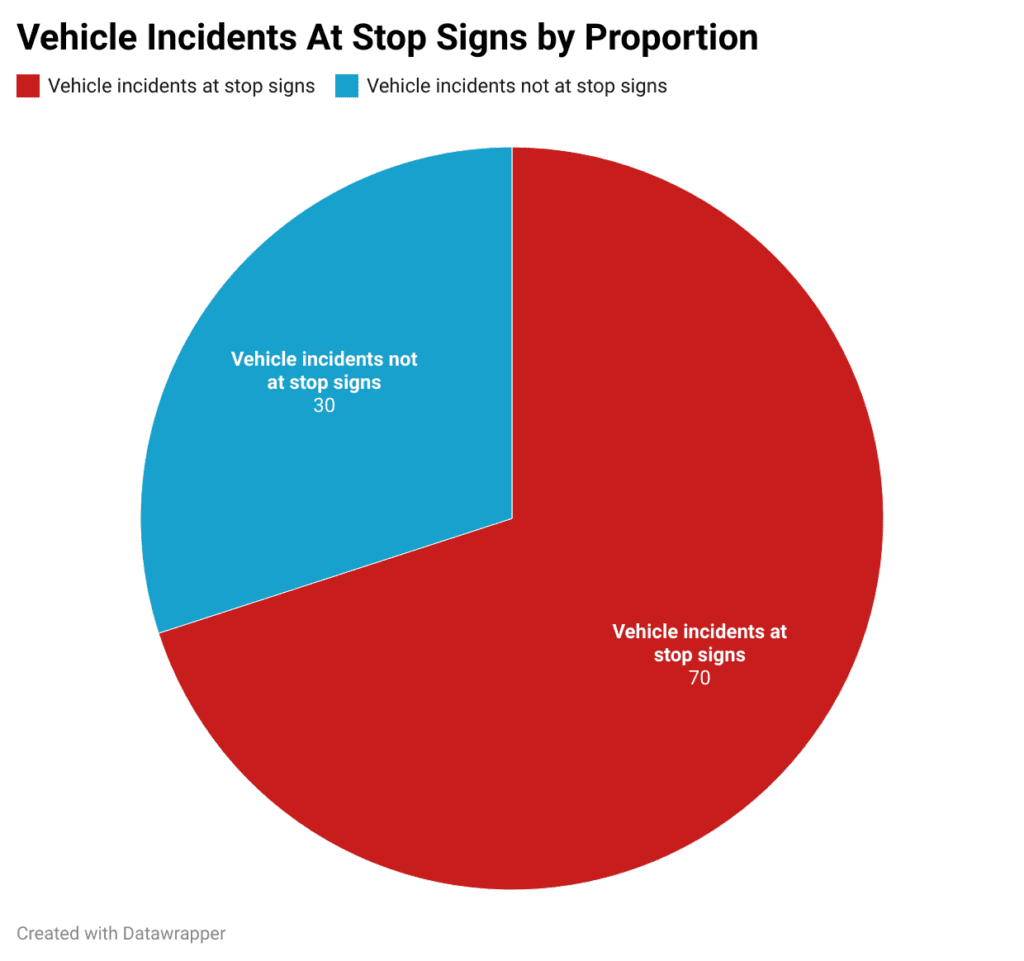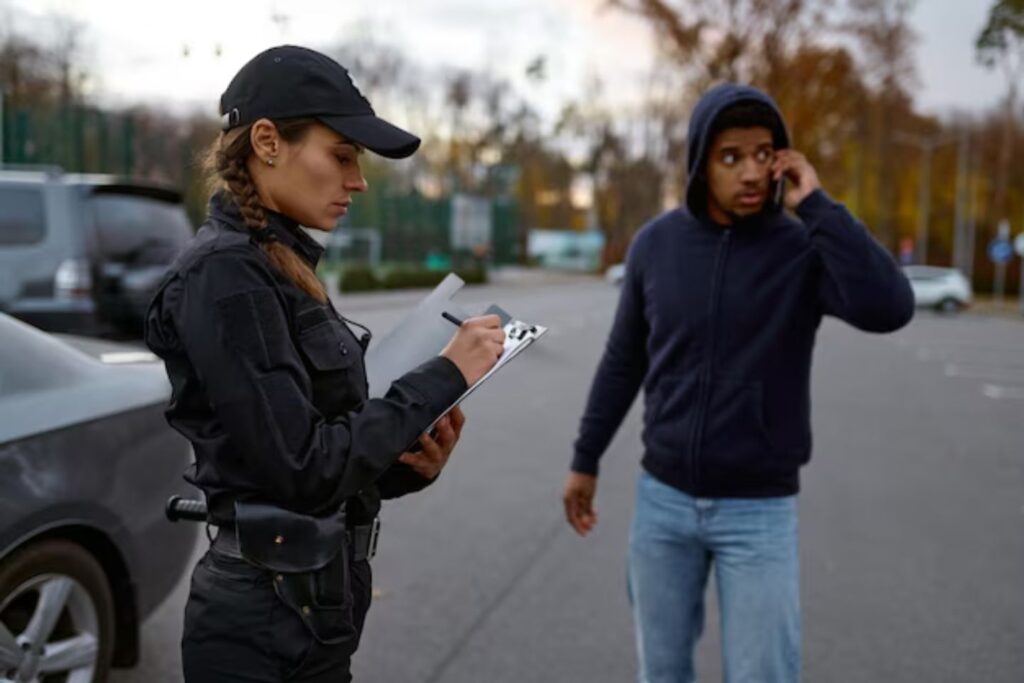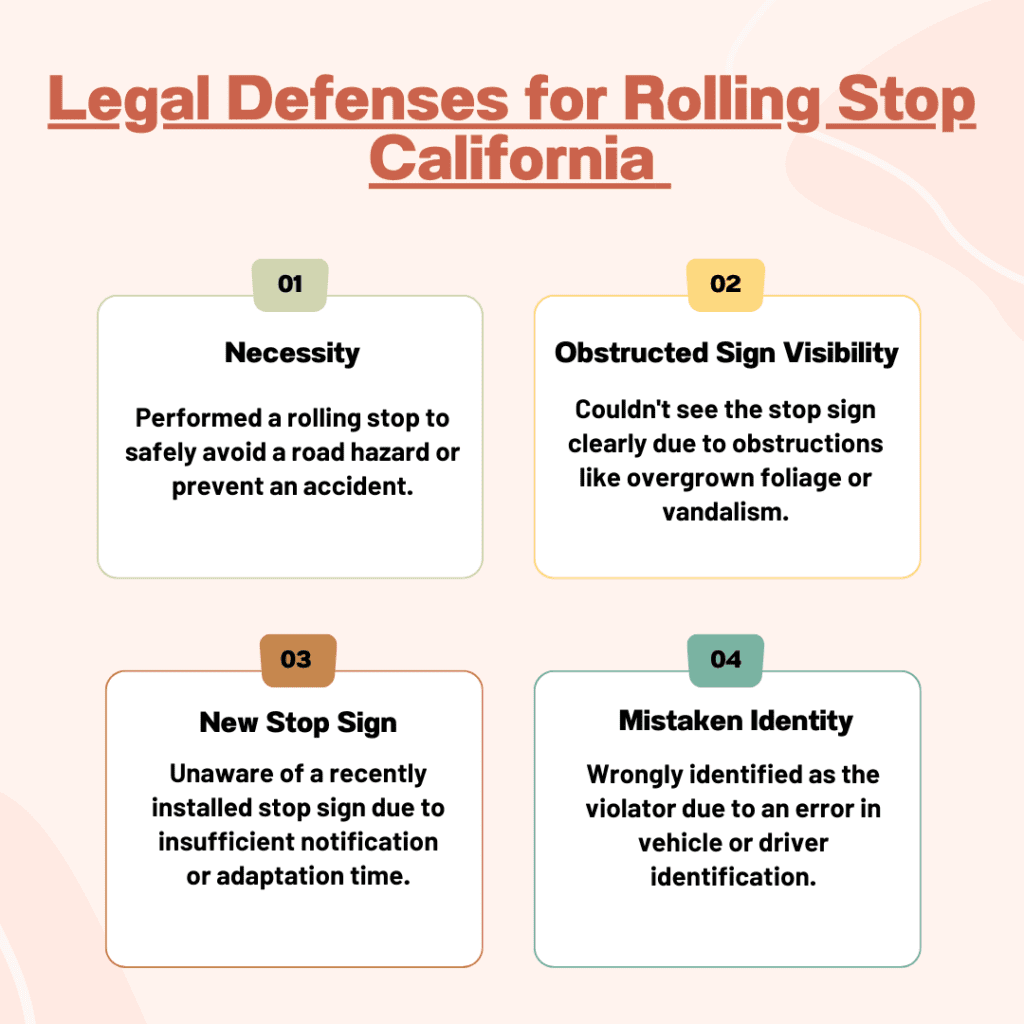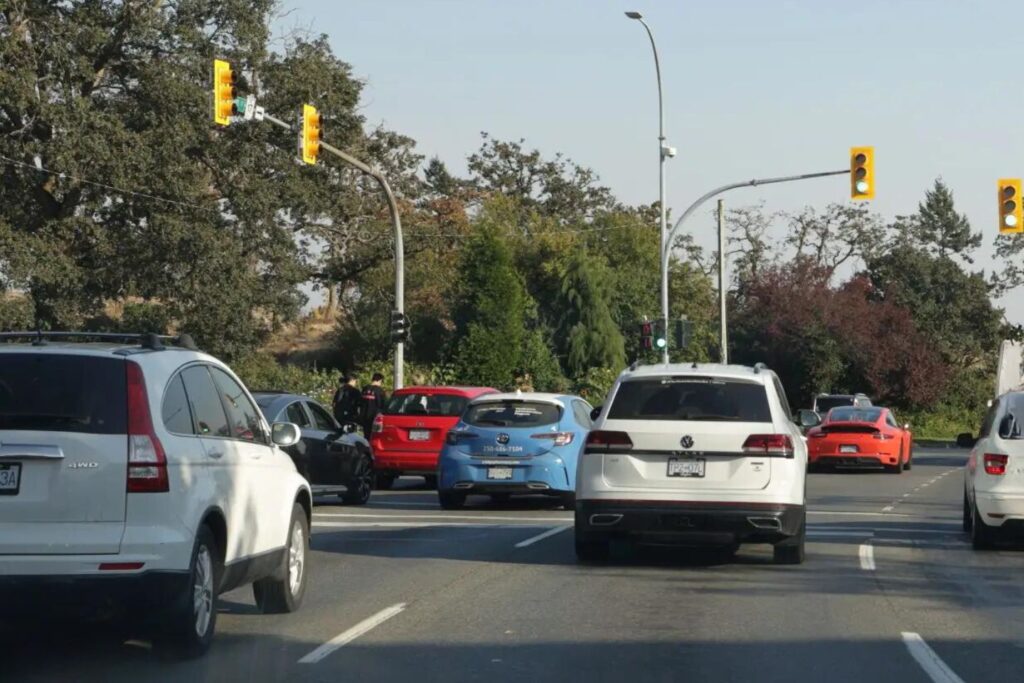According to a study analyzing more than 7,000,000 vehicle incidents, more than 70% of all crashes occur at stop signs of which one-third involve injuries. Driving in California means you need to know and follow the state’s traffic laws, especially when it comes to stopping fully at stop signs and red lights. You need to understand that rolling stop in California is illegal and unsafe.
This article explains what you might face if you don’t stop completely, like fines, higher insurance costs, and stricter penalties in certain places. Similarly, this article also provides legal tips and mitigation strategies that can assist you in court against rolling stop California violations.


- What is a Rolling Stop?
- Common Scenarios of Rolling Stops
- The California Rolling Stop Vehicle Code
- Consequences of a Rolling Stop in California
- What To Do If You Are A Victim of a Rolling Stop California
- Circumstances That May Mitigate the Penalties for a Rolling Stop California
- Preventing Rolling Stop California: Tips for California Drivers
What is a Rolling Stop?
A rolling stop happens when a driver doesn’t fully stop at a stop sign or red light, choosing instead to slow down just a bit before moving on. This move, sometimes called a California stop, goes against traffic rules meant to keep intersections and crosswalks safe.
In California, drivers are required to make a complete stop at stop signs and red lights, and not doing so could lead to a ticket. Knowing what a rolling stop is and following the law can help make the roads safer for everyone.
Common Scenarios of Rolling Stops
According to the Federal Highway Administration, 50% of crashes occur at or near intersections. Drivers often commit rolling stops in several common scenarios leading to violations of traffic laws.
- Rushing Through Empty Intersections: Some drivers, seeing an intersection almost empty, decide to speed through without stopping. This choice, despite seeming safe due to the lack of traffic, still breaks the law and overlooks potential hidden dangers, such as unseen vehicles or pedestrians.
- Treating Stop Signs as Yield Signs in Residential Areas: In quieter, residential neighborhoods, it’s common for drivers to slow down just enough to look around before proceeding through a stop sign, rather than coming to a complete stop. This behavior treats stop signs more like yield signs and can lead to unexpected hazards, including close calls with children or pets.
- Making Right Turns at Red Lights Without a Full Stop: When turning right at a red light, the law requires a complete stop first to check for oncoming traffic and pedestrians. Skipping this step not only violates traffic laws but also increases the chance of turning into the path of another vehicle or pedestrian crossing the street.
- Accelerating Through Yellow Lights to Avoid Red: Drivers often misjudge or intentionally speed up when facing a yellow light, aiming to cross the intersection before it turns red. This hurried decision can lead to a rolling stop scenario if the light changes to red as you enter the intersection.
The California Rolling Stop Vehicle Code
The California Vehicle Code outlines specific rules regarding rolling stops, emphasizing the necessity for drivers to fully halt at stop signs and red lights. Sections that imply rolling stops in California include the following.
- Right-of-Way at Stop Signs (CVC 21802): Drivers must stop at the line, crosswalk, or intersection entrance when they approach a stop sign. The right-of-way must be yielded to vehicles already in the intersection or arriving on another road who are close enough to pose a hazard.
- Stop Requirements at Railroad Crossings (CVC 22451): Drivers are required to stop at railroad crossings when signals indicate a train is approaching, gates are lowered, flagman signals or a train is visibly near and poses a hazard.
- Red Signal—Stop Requirements (CVC 21453): Facing a steady red light or arrow, drivers must stop at the marked line, or before entering the crosswalk or intersection if no line or crosswalk is present. Vehicles must wait until it’s legally safe to proceed, indicated by a change in the signal.
- Stop Signs at Railroad Crossings (CVC 22452): Special vehicles, like school buses and those carrying hazardous materials, must always stop at railroad crossings, whether or not a train is approaching. This rule prioritizes the safety of passengers and the general public by preventing potential accidents.
Legal Difference Between a Rolling Stop and a Complete Stop
California law differentiates between a rolling stop and a complete stop based on whether the vehicle fully stops moving. For a stop to be considered complete, your vehicle must come to a total halt, which is usually noticeable when the wheels are no longer turning.
On the other hand, a rolling stop happens when the vehicle slows down but continues to move, without ever fully stopping. This difference is crucial for authorities and drivers like yourself to understand, highlighting the necessity of following stopping laws strictly to maintain public safety.
Consequences of a Rolling Stop in California
In California, committing a rolling stop can lead to significant consequences, including legal penalties, increased insurance premiums, and enhanced penalties in certain areas.
Here’s what you need to know:
Penalties for Rolling Stops under California Law
If caught performing a rolling stop, you could face a fine, although this can vary with court fees and the specific location of the violation. Additionally, a rolling stop violation adds one point to your driving record. Accumulating points can lead to higher insurance costs and, in some cases, license suspension. If you crash your car due to a rolling stop, it’s important to take the right steps to ensure medical and legal safety.
How Rolling Stops Affect Insurance Premiums
A ticket for a rolling stop signals to insurance companies that you might be a riskier driver, leading to an increase in insurance premiums. This is because traffic violations are seen as a higher risk for accidents and insurance claims. The rise in premiums serves as a financial reminder of the importance of adhering to traffic laws, potentially affecting your insurance costs for years.
Increased Penalties in Special Zones
The consequences for rolling stops are even more severe in areas like school zones or pedestrian crossings according to California Law 42010. Fines can double in these zones to reflect the increased risk and importance of pedestrian safety. This approach underscores California’s commitment to ensuring the highest level of safety in sensitive areas and acts as a deterrent against unsafe driving behaviors.
What To Do If You Are A Victim of a Rolling Stop California


If you find yourself on the receiving end of an incident involving a rolling stop, whether as a pedestrian, cyclist, or another driver, it’s important to know how to respond effectively and protect your rights. Here’s what you should do:
- Call the Authorities: Report the event to the police by phone if the circumstances call for it, such as when there has been serious property damage or an injury. A written report may be essential when filing an insurance claim or considering legal action.
- Gather Information: Collect as much information as you can about the incident, including the driver’s license plate number, vehicle description, and any witness contact details. If it’s safe and you’re able to, take photos of the scene and any damages.
- Seek Medical Attention: You might not notice some injuries right away, even if you feel good. Getting a medical checkup is a good idea to make sure any concealed injuries are found and addressed right away.
- Consider Legal Advice: If you’re facing challenges with insurance claims or believe you’re entitled to compensation for injuries or damages, consulting with a legal professional can provide clarity and direction on how to proceed.
For personalized advice on navigating the legal consequences of a rolling stop in California, contact The Personal Injury Center and safeguard your driving privileges. We connect you to the best attorneys in your region so your case is dealt with the focus it deserves.
Legal Defenses for Rolling Stop California
In California, if you are cited for rolling stops, you have the opportunity to present legal defenses that may reduce penalties or lead to the dismissal of the charge.
Necessity
If you performed a rolling stop to dodge a sudden road hazard or avoid a crash, you might use the necessity defense. This means you’re arguing that your quick decision to not fully stop was actually a safety measure, prioritizing avoiding danger over following the letter of the law to the T. Essentially, you’re saying that at that moment, making a rolling stop was the safest thing you could do to protect yourself and others.
Obstructed Sign Visibility
Sometimes, you might not fully stop because you genuinely didn’t see the stop sign, maybe due to overgrown trees, graffiti, or something else blocking your view. If this was the case, you could argue that you couldn’t comply with the stop requirement because the sign wasn’t clearly visible.
To make this defense work, you need to prove that the sign was indeed hard to spot for any attentive driver, showing that your rolling stop wasn’t a careless act but a result of unexpected circumstances.
New Stop Sign
If a stop sign was recently put up and you weren’t aware of it, this might be your defense. You’d need to demonstrate that the sign was a new addition and that there wasn’t enough communication or time for you to get used to this change. This argument rests on the idea that you follow traffic rules you know about, and a new, unfamiliar sign caught you off guard.
Mistaken Identity
Claiming mistaken identity means you’re saying you were wrongly identified as the one who made the rolling stop. Maybe the officer got the car or driver wrong. To successfully use this defense, you must provide solid evidence or trustworthy statements that prove you weren’t the one behind the wheel or that the vehicle cited wasn’t yours. It underscores the need for precise identification when it comes to traffic violations.


Circumstances That May Mitigate the Penalties for a Rolling Stop California


Several key circumstances may lead to lighter penalties or dismissal for rolling stop violations.
These include the following:
Clean Driving Record
If you’ve kept a clean driving record up until now, this could work in your favor. Courts often consider a driver’s history when deciding on penalties. A spotless record might lead to a lighter sentence, possibly a reduced fine, or the chance to go to traffic school instead of having points added to your license. It’s a way of acknowledging your overall responsible driving behavior, suggesting this incident is an exception, not a pattern.
Confusion Due to Poor Signage
Sometimes, the real issue leading to a rolling stop is confusing or poorly marked signage. If you can show that the signage at the intersection was unclear or misleading, this might explain why you didn’t come to a complete stop. This defense focuses on the environment’s role in the violation, suggesting that with clearer guidance, the incident could have been avoided.
Demonstration of Remorse
Acknowledging the seriousness of your actions and showing genuine remorse can also influence the outcome. If you express an understanding of the risks your rolling stop posed to public safety and sincerely apologize, it may persuade the court to be more lenient. This approach shows you’re taking responsibility for your actions and are committed to safer driving practices in the future.
Court’s Discretion
Finally, there may be personal circumstances or specific details about the incident that could lead the court to show leniency. Whether it’s a challenging personal situation that influenced your driving at the time or mitigating factors surrounding the violation, highlighting these can make a difference. This defense relies on the court’s capacity for empathy and understanding, emphasizing that justice can be tempered with mercy based on the context.
Preventing Rolling Stop California: Tips for California Drivers
To help California drivers avoid the risks and penalties associated with rolling stops, here are some practical tips:
- Familiarize Yourself with Traffic Laws: Take the time to review California’s traffic regulations, especially those related to stop signs and red lights, to ensure you understand what’s required.
- Practice Full Stops at Stop Signs and Red Lights: Make it a habit to come to a complete stop at all stop signs and red lights, ensuring your vehicle is fully stationary before proceeding.
- Stay Alert and Minimize Distractions: Pay attention to the road and your surroundings. Avoid distractions like mobile phones, eating, or anything else that takes your focus away from driving.
- Keep a Safe Following Distance: Maintaining a safe distance from the vehicle ahead gives you more time to react and stop when approaching stop signs or signals.
- Get Legal Support: If you find yourself facing a traffic citation for a rolling stop or any other violation, consider seeking advice from a legal professional specializing in traffic laws.
After learning about California’s rolling stop laws, take the next step: contact The Personal Injury Center, and we will get you in touch with lawyers for dedicated legal assistance tailored to your situation.



